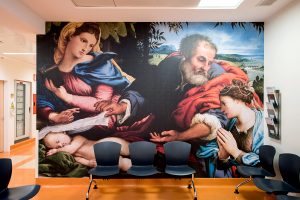Interview to Massimo Castoldi, Health Care Director of Humanitas Gavazzeni e Castelli, Bergamo

How did the Care and Beauty project come about?
From a challenge and a happy intuition: to bring the Beauty kept in the Accademia Carrara in the two Humanitas hospitals of Bergamo in an innovative way. In the past, some interesting artistic projects had already been done, such as “Energy of Beauty”, a collaboration with the Atelier of the Error, which still covers the walls of our Radiotherapy department. At the base of the project we accomplished in 2018, there is the desire to experiment and find new ways to express the passion of caring. A complex concept, which includes very technical and operational dimensions, such as avant-garde skills and equipment, but also very “smooth” dimensions, such as the protection of human value when facing pain and illness.
How did the collaboration with Accademia Carrara develop?
There was a first collaboration from which the spark was born: last summer, a painting by Mantegna attributed to the painter – Resurrection of Christ – was subjected to X-Ray and CT of our imaging diagnostic department before proceeding to restoration. It was a very exciting event: it was an opportunity to put ourselves to test on a new front, mixing knowledge and working side by side with the curators of the Pinacoteca. From there the idea: to get art out of the museum to bring it into the hospital.
Has the fact that the Accademia Carrara heritage consists mainly of Classical Art represented a limit?
No. It was the condition from which we started to select details of works of art that convey emotions: smiling faces, gestures of care and affection, landscapes. Personally, then, I believe that reading and emotional resonance with classical iconography are easier.
All of us employees and care providers at Humanitas Gavazzeni and Castelli have chosen some of the most iconic works of this artistic path that deliberately began in the walking areas and socialization of the hospital, those with the highest attendance such as bars, canteen and waiting rooms. We chose paintings that could better reconstruct an environment with a strong emotional impact, following the theme of beauty declined in many ways consistent with the hospital that welcomes them. An example is the symbolic image of the whole project, St. Jerome and the Lion, evocative of the gesture of care and with a strong connection to Bergamo, with the symbol of the animal that is still found today on the Venetian walls of the upper city.

What has changed after the posting of the paintings in Humanitas Gavazzeni for the patients and their families?
The patients stop us to tell us that the smiles of the characters of the paintings convey serenity to them. Even in dark moments of waiting, of suspension. It also happens to find relatives of patients who, while waiting, map in hand (we distribute free artistic maps and postcards at the entrances), go in search of works of art by walking through the corridors of hospitals and asking our staff for indication. We can say that the way of living in the hospital is changing. Certainly no one expects to find 400 square meters of artistic beauty in a place dedicated to care. And not even that there are masterpieces of great masters of the past, such as Raphael, Bellini, Lotto, Hayez and Botticelli.
What has changed since the posting of the paintings in Humanitas Gavazzeni for you healthcare professionals?
The project has given us new horizons of conversation and dialogue. Speaking of art, learning notions about the paintings chosen, training our ability to interpret paintings, we go beyond the daily uniforms, white coats and roles. The free beauty of art has strengthened the desire for sharing.
What other initiatives would you like to continue experimenting with art as a language of care?
We are just at the beginning of a journey. We want to continue to make “The Care and the Beauty” alive, not as a static show but as a reason for meeting people and for creating exciting stories, inserting it more and more into the path of patient care.
